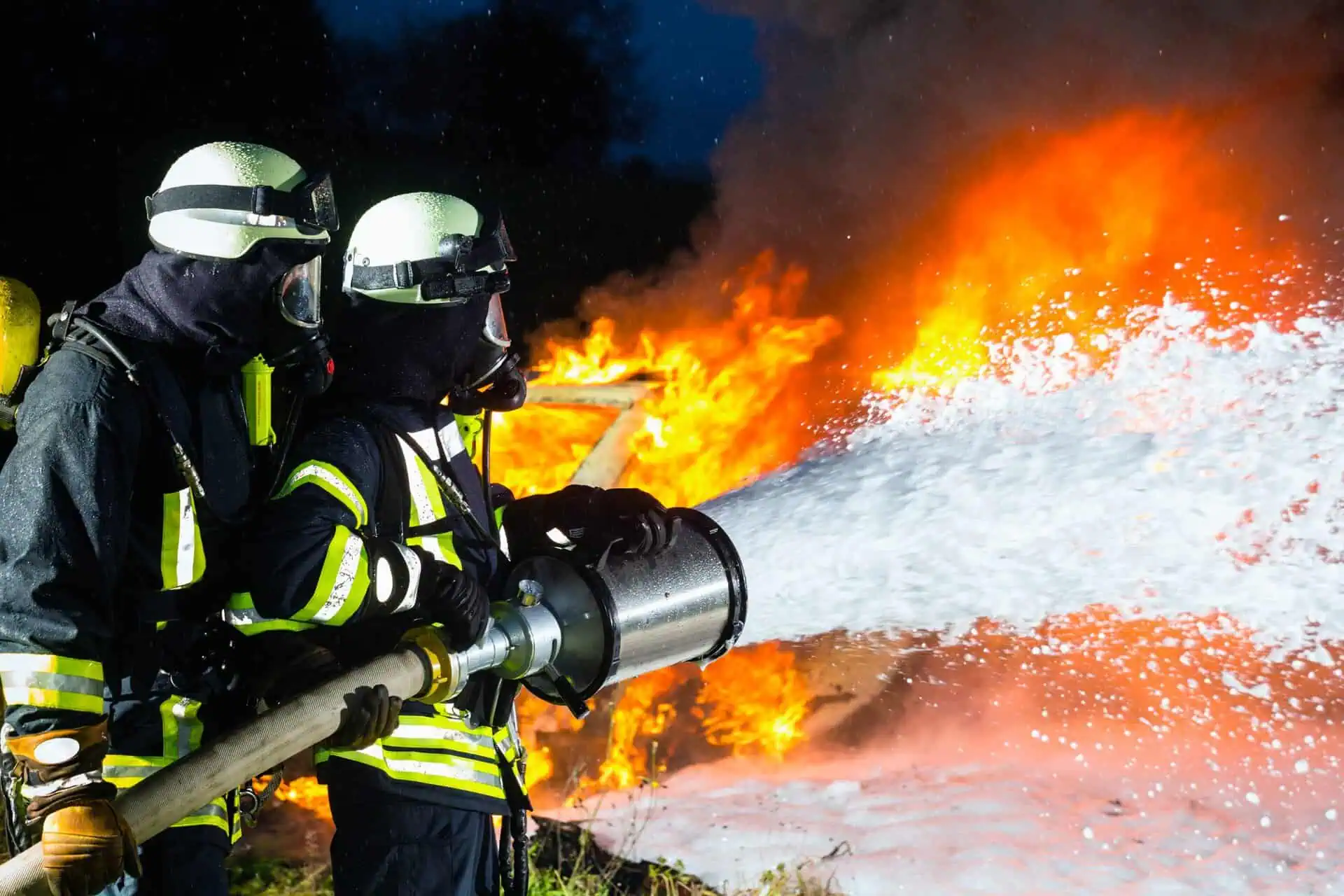Firefighting Foam Cancer Lawsuit
- Last Updated: June 12th, 2025

Attorney Jessica Paluch-Hoerman, founder of TruLaw, has over 28 years of experience as a personal injury and mass tort attorney, and previously worked as an international tax attorney at Deloitte. Jessie collaborates with attorneys nationwide — enabling her to share reliable, up-to-date legal information with our readers.
Legally Reviewed
This article has been written and reviewed for legal accuracy and clarity by the team of writers and legal experts at TruLaw and is as accurate as possible. This content should not be taken as legal advice from an attorney. If you would like to learn more about our owner and experienced injury lawyer, Jessie Paluch, you can do so here.
Fact-Checked
TruLaw does everything possible to make sure the information in this article is up to date and accurate. If you need specific legal advice about your case, contact us by using the chat on the bottom of this page. This article should not be taken as advice from an attorney.
Key takeaways:
- The ongoing Firefighting Foam Cancer Lawsuits shed light on the potential health risks associated with Aqueous Film-Forming Foam (AFFF) exposure, particularly its links to certain types of cancer.
- The AFFF Lawsuit Update 2023 informs individuals about the current state of litigation and their legal rights if they have been affected by AFFF exposure. It empowers them to seek compensation and justice.
- The lawsuits underscore the importance of holding firefighting foam manufacturers and users accountable for ensuring safer alternatives and proper handling to protect public health and the environment.
Overview of the Firefighting Foam Cancer Lawsuit
On this page, we’ll provide an overview of the firefighting foam cancer lawsuit, studies linking AFFF firefighting foam to cancer, who qualifies to file an AFFF Lawsuit, and much more.
Aqueous Film Forming Foam (AFFF) has been used since the 1960s in environments such as military bases, airports, chemical plants, and other industrial facilities to combat dangerous fires.
Originally developed by 3M and the U.S. Navy, AFFF contains PFAS chemicals—commonly referred to as “forever chemicals”—which have been linked to several types of cancer and other serious health issues.
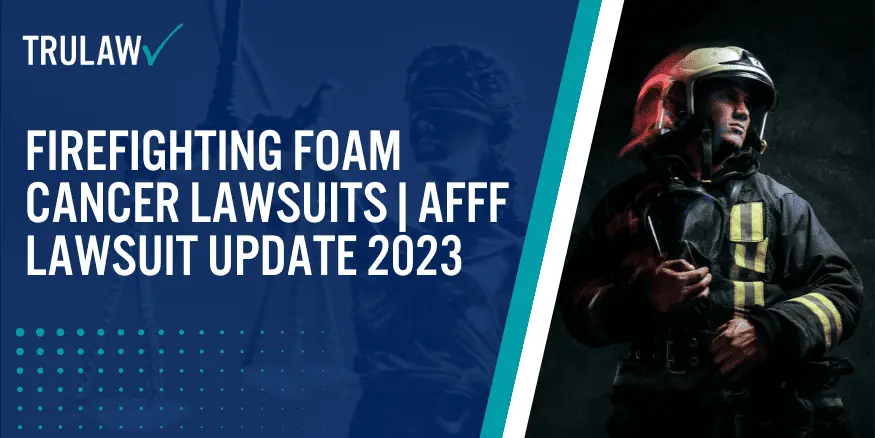
If you or a loved one were exposed to AFFF and later diagnosed with cancer, you may be eligible to pursue legal action through a firefighting foam cancer lawsuit.
These AFFF firefighting foam lawsuits seek to hold AFFF manufacturers accountable for the health problems associated with AFFF exposure.
Use the chatbot on this page for an instant case evaluation to determine if you qualify for an AFFF firefighting foam cancer lawsuit today.
Table of Contents
Which Cancer Diagnoses Have Been Linked to AFFF Exposure?
Exposure to AFFF firefighting foam, and the PFAS chemicals it contains, may be linked to several types of cancer.
AFFF manufacturers may have known — or should have known — that their products contained harmful chemicals associated with cancer and other health risks.
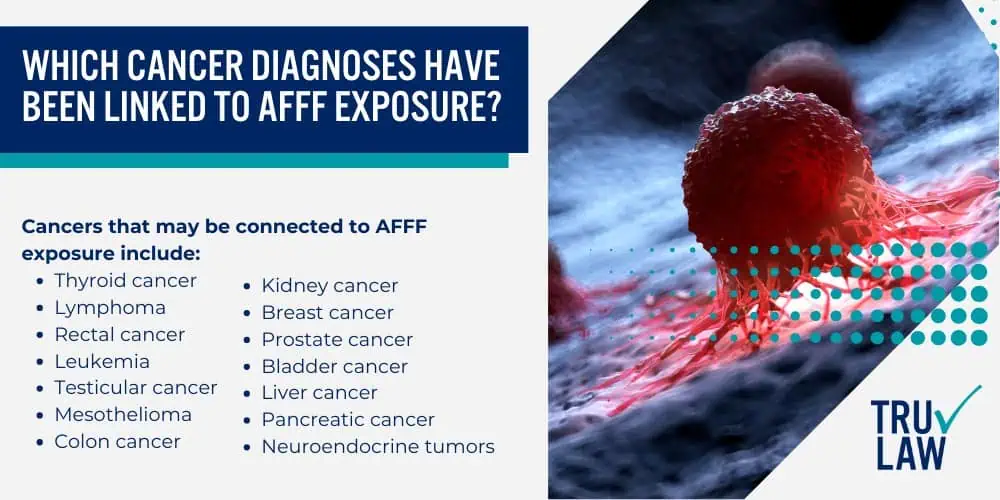
Cancers that may be connected to AFFF exposure include:
- Thyroid cancer
- Lymphoma
- Rectal cancer
- Leukemia
- Testicular cancer
- Mesothelioma
- Colon cancer
- Kidney cancer
- Breast cancer
- Prostate cancer
- Bladder cancer
- Liver cancer
- Pancreatic cancer
- Neuroendocrine tumors
Some of the most commonly reported cancers in current AFFF lawsuits include prostate cancer, testicular cancer, kidney cancer, thyroid cancer, and pancreatic cancer.
If you or a loved one were diagnosed with cancer after exposure to AFFF, you may be eligible to file an AFFF lawsuit and seek compensation.
Who May Be at Risk for AFFF Firefighting Foam Exposure?
People at risk for exposure to AFFF include firefighters, airport personnel, military firefighters, and industrial workers, as well as individuals who live near facilities that use AFFF, where water contamination may occur.
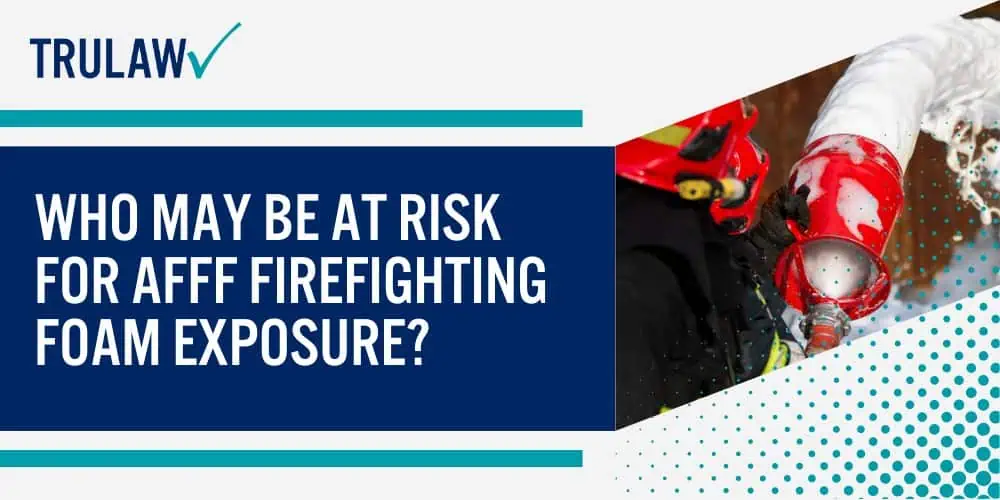
Others who may be at higher risk for developing cancer include workers involved in producing, transporting, or cleaning up toxic firefighting foam.
Studies Link PFAS Chemicals in AFFF Firefighting Foam to Cancer & More
Research from various respected institutions, including the Environmental Protection Agency, National Research Council, and Centers for Disease Control, has highlighted the potential dangers of PFAS chemicals, commonly referred to as “forever chemicals.”
These toxic chemicals, found in AFFF firefighting foam, have been associated with an increased risk of developing several types of cancer.
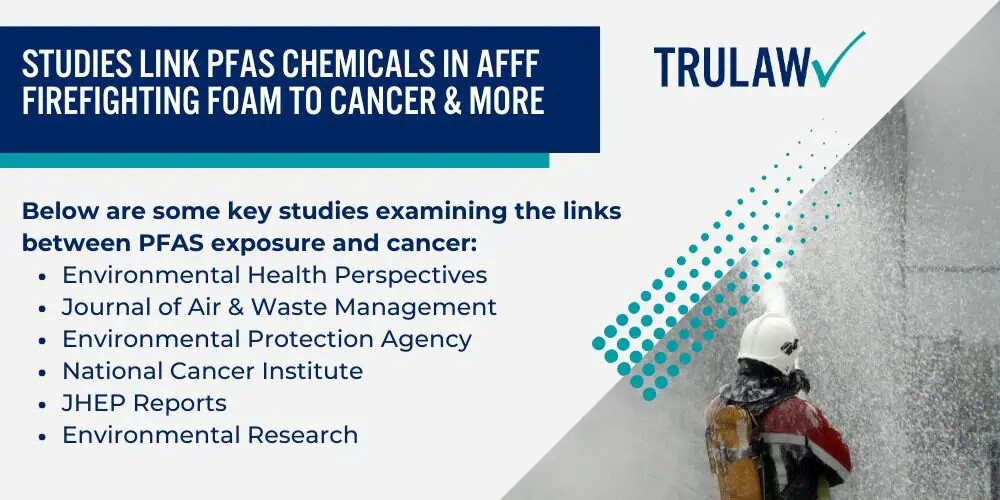
Below are some key studies examining the links between PFAS exposure and cancer:
- Environmental Health Perspectives: Perfluorooctanoic acid (PFOA) exposures and incident cancers among adults living near a chemical plant
- Journal of Air & Waste Management: Review on PFOA, kidney cancer, and testicular cancer
- Environmental Protection Agency: Our current understanding of the human health and environmental risks of PFAS
- National Cancer Institute: PFAS exposure and risk of cancer
- JHEP Reports: Exposure to perfluoroalkyl substances and risk of hepatocellular carcinoma in a multiethnic cohort
- Environmental Research: PFAS and cancer, a scoping review of the epidemiologic evidence
Actions to Limit AFFF Exposure and Use
Several agencies and organizations are actively working to reduce the use of AFFF containing PFAS chemicals, recognizing the potential health risks associated with exposure.
These efforts are aimed at replacing the foam with safer alternatives and eventually eliminating its use altogether.
- The Pentagon has been instrumental in driving changes, announcing plans to introduce PFAS-free firefighting foam for military personnel in the coming year.
- The U.S. Department of Defense laid out a plan in 2022 to phase out the use of AFFF, focusing on safer firefighting technologies for the future.
- The Federal Aviation Administration is leading efforts to replace AFFF in airports across the U.S., developing new foam products without harmful chemicals like PFAS.
These actions reflect the growing awareness and concern over the health impacts of PFAS, as institutions work to create safer firefighting solutions.
Do You Qualify to File a Firefighting Foam Cancer Lawsuit?
Exposure to Aqueous Film Forming Foam (AFFF) has been linked to several serious health problems, including an increased risk of developing cancer.
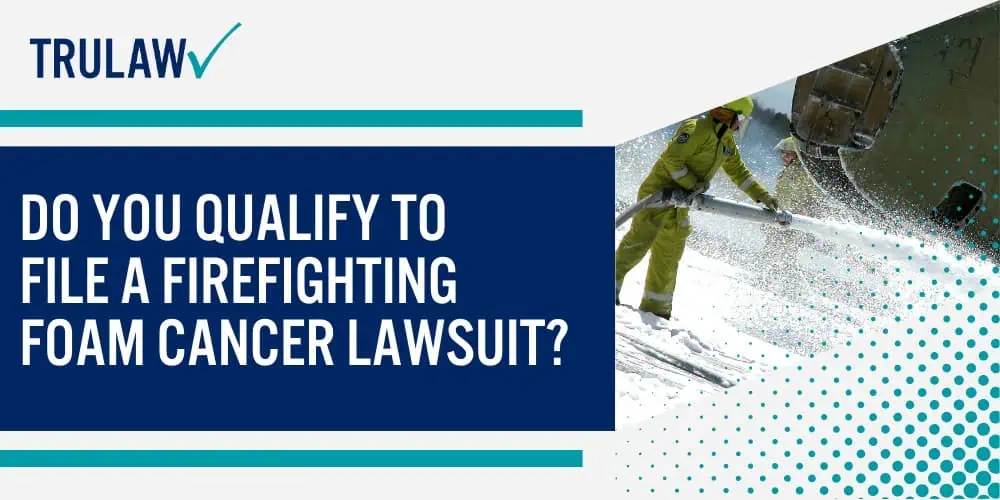
If you or a loved one has been exposed to AFFF and later diagnosed with cancer, you may be eligible to pursue legal action.
If a loved one has tragically passed away from cancer potentially linked to AFFF exposure, you may also qualify to file an AFFF lawsuit on their behalf.
Contact TruLaw by using the chat on this page to receive an instant case evaluation and determine if you qualify to file an AFFF lawsuit.
Gathering Evidence for an AFFF Firefighting Foam Lawsuit
The success of an AFFF lawsuit often depends on gathering strong evidence to demonstrate exposure has definitively occurred.
Anything that documents your or your loved one’s exposure to firefighting foam should be provided to the firefighting foam cancer lawyers working on your case.
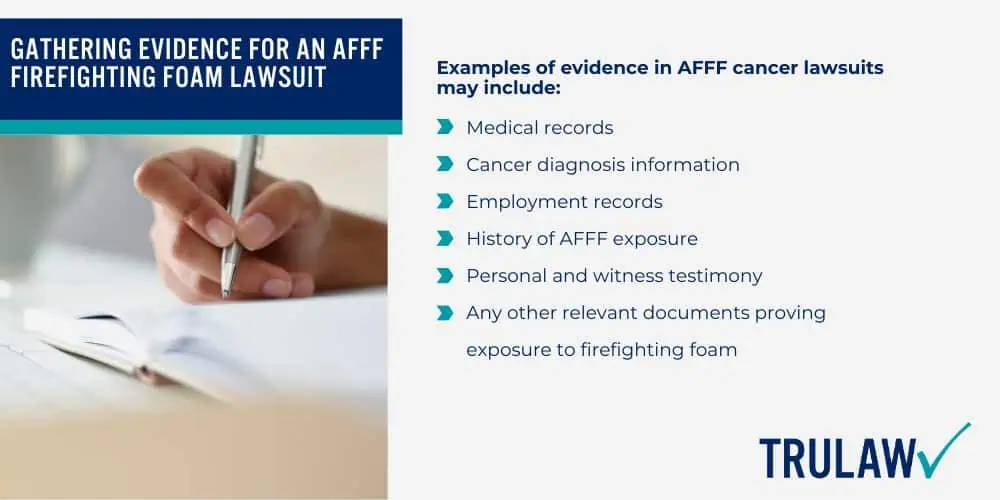
Examples of evidence in AFFF cancer lawsuits may include:
- Medical records
- Cancer diagnosis information
- Employment records
- History of AFFF exposure
- Personal and witness testimony
- Any other relevant documents proving exposure to firefighting foam
The AFFF lawyers at TruLaw and our partner law firms will assist you in collecting and preserving this evidence to strengthen your AFFF claim.
Potential Damages in an AFFF Cancer Lawsuit
Damages in an AFFF lawsuit refer to the losses you have experienced due to exposure to firefighting foam.
Cancer treatment is often costly, and these medical expenses, along with other losses, can be included in your claim for financial compensation.
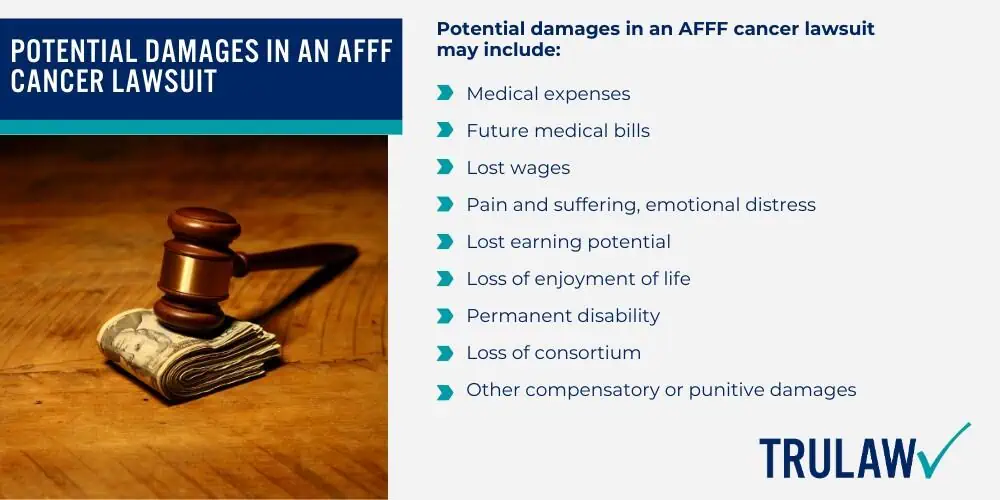
Potential damages in an AFFF cancer lawsuit may include:
- Medical expenses
- Future medical bills
- Lost wages
- Pain and suffering, emotional distress
- Lost earning potential
- Loss of enjoyment of life
- Permanent disability
- Loss of consortium
- Other compensatory or punitive damages
Determining Liability in Firefighting Foam Cancer Lawsuits
Liability in AFFF lawsuits may involve multiple companies, including manufacturers of the foam.
Determining who may be responsible for your cancer diagnosis often depends on factors such as your employment history and specific exposure details.
Use the chat on this page for an instant case evaluation to determine if you qualify to file an AFFF cancer lawsuit.
TruLaw: Your Firefighting Foam Cancer Law Firm
The AFFF lawyers at TruLaw and our partner law firms are currently assisting clients across all (50) states who may have been affected by AFFF exposure and related health issues.
If you or a loved one were exposed to AFFF and have since developed cancer, you may be eligible to file an AFFF lawsuit.
Reach out to us today for more information by using the chatbot on this page to instantly check if you qualify for an AFFF cancer lawsuit.
It’s important to note that TruLaw is only accepting clients with AFFF personal injury claims — we are not accepting clients for the AFFF municipal water contamination lawsuits.
AFFF Lawsuit Frequently Asked Questions
-
What is Aqueous Film Forming Foam (AFFF) and how does it function?
Aqueous Film Forming Foam (AFFF) is a firefighting foam concentrate mixed with water to combat Class B fires, which are fueled by substances like oil, chemicals, and jet fuel.
When applied, AFFF creates a thin film that suffocates the fire by cutting off its oxygen supply, preventing it from reigniting.
For decades, AFFF has been widely used due to its effectiveness in handling dangerous and difficult-to-extinguish fuel fires.
However, concerns about its safety have emerged in recent years.
-
What are the issues with AFFF firefighting foam?
AFFF contains Perfluoroalkyl and Polyfluoroalkyl Substances (PFAS), which are synthetic chemicals known to pose health risks.
PFAS chemicals have been linked to a variety of harmful health effects, including cancer, due to their persistence in the environment and their ability to accumulate in the human body over time.
-
Is AFFF firefighting foam still in use today?
Although AFFF has been largely replaced by alternative fire suppression methods that don’t contain PFAS, it is still used in extreme situations where its effectiveness is necessary.
Due to its long shelf life and proven performance in fighting stubborn fuel fires, some facilities and emergency services continue to store and use AFFF in limited circumstances.
-
Who is most at risk of being exposed to AFFF firefighting foam?
Those most at risk of being exposed to AFFF firefighting foam are individuals who regularly worked with or around the product for long periods of time — presenting a larger concern for certain professions compared to others.
Individuals in the following professions are among the most likely to experience AFFF exposure:
- Workers at industrial sites like oil refineries
- Transporters of AFFF firefighting foam
- Municipal firefighters
- Airport and military firefighters
- Workers at incinerator facilities responsible for disposing of firefighting foam
- Individuals who worked on flight decks
- Employees of AFFF manufacturers
-
Who are the defendants in AFFF lawsuits?
Defendants in AFFF lawsuits include companies that supplied firefighting foam to various entities such as fire departments, military bases, and airports.
Some of the companies named in these lawsuits include:
- ChemDesign Inc.
- DuPont
- Tyco Fire Products
- Chemours
- 3M
- Chemguard Inc.
- Over a dozen additional companies
These companies are being sued for allegedly producing and distributing AFFF containing harmful PFAS chemicals.
-
What is the AFFF firefighting foam MDL?
The AFFF MDL (multidistrict litigation) has been centralized in the US District Court for the District of South Carolina.
MDL is a federal legal process designed to efficiently manage cases that involve many similar claims.
By consolidating AFFF firefighting foam cases into an MDL, the court can address all pretrial procedures in one location to make it easier to manage a large number of related lawsuits.
-
How can firefighting foam lawyers assist with filing an AFFF lawsuit?
The firefighting foam lawyers at TruLaw and our partner law firms are dedicated to holding large corporations and firefighting foam manufacturers accountable for the harm caused by AFFF exposure.
AFFF lawyers can assist in a variety of ways, including:
- Identifying the parties responsible for your cancer diagnosis
- Providing guidance through the legal process and answering any questions you may have
- Evaluating the impact of your exposure and assessing damages
- Striving to achieve a settlement in your AFFF cancer lawsuit
- Collecting evidence for your AFFF lawsuit
-
What are the costs of hiring a firefighting foam attorney to file an AFFF lawsuit?
TruLaw and our partner law firms operate on a contingency fee basis, which means there are no upfront legal fees for representation.
You only pay if your case results in a successful settlement or verdict.
If no compensation is awarded, you won’t owe any legal fees for your AFFF lawsuit.
This arrangement helps ensure that you can pursue your claim without financial risk.
-
What is the average AFFF lawsuit settlement?
There has not yet been a settlement in the AFFF firefighting foam lawsuits.
However, attorneys estimate that potential settlement amounts for AFFF lawsuits could range from $20,000 to $600,000 (or more), depending on the specific circumstances and strength of each case.
These estimates are not guarantees, but projections based on outcomes in previous mass tort cases, especially those involving cancer diagnoses from toxic exposures.
For more personalized information on what to expect in your case, we recommend consulting with the experienced AFFF lawyers at TruLaw and our partner law firms to explore potential outcomes for your firefighting foam lawsuit.
You can do so by using the chat on this page for an instant case evaluation determine if you qualify to file an AFFF lawsuit.

Managing Attorney & Owner
With over 25 years of legal experience, Jessica Paluch-Hoerman is an Illinois lawyer, a CPA, and a mother of three. She spent the first decade of her career working as an international tax attorney at Deloitte.
In 2009, Jessie co-founded her own law firm with her husband – which has scaled to over 30 employees since its conception.
In 2016, Jessie founded TruLaw, which allows her to collaborate with attorneys and legal experts across the United States on a daily basis. This hypervaluable network of experts is what enables her to share the most reliable, accurate, and up-to-date legal information with our readers!
Additional AFFF Lawsuit resources on our website:
Here, at TruLaw, we’re committed to helping victims get the justice they deserve.
Alongside our partner law firms, we have successfully collected over $3 Billion in verdicts and settlements on behalf of injured individuals.
Would you like our help?
At TruLaw, we fiercely combat corporations that endanger individuals’ well-being. If you’ve suffered injuries and believe these well-funded entities should be held accountable, we’re here for you.
With TruLaw, you gain access to successful and seasoned lawyers who maximize your chances of success. Our lawyers invest in you—they do not receive a dime until your lawsuit reaches a successful resolution!
AFFF Lawsuit claims are being filed against manufacturers of aqueous film-forming foam (AFFF), commonly used in firefighting.
Claims allege that companies such as 3M, DuPont, and Tyco Fire Products failed to adequately warn users about the potential dangers of AFFF exposure — including increased risks of various cancers and diseases.
Depo Provera Lawsuit claims are being filed by individuals who allege they developed meningioma (a type of brain tumor) after receiving Depo-Provera birth control injections.
A 2024 study found that women using Depo-Provera for at least 1 year are five times more likely to develop meningioma brain tumors compared to those not using the drug.
Suboxone Tooth Decay Lawsuit claims are being filed against Indivior, the manufacturer of Suboxone, a medication used to treat opioid addiction.
Claims allege that Indivior failed to adequately warn users about the potential dangers of severe tooth decay and dental injuries associated with Suboxone’s sublingual film version.
Social Media Harm Lawsuits are being filed against social media companies for allegedly causing mental health issues in children and teens.
Claims allege that companies like Meta, Google, ByteDance, and Snap designed addictive platforms that led to anxiety, depression, and other mental health issues without adequately warning users or parents.
Transvaginal Mesh Lawsuits are being filed against manufacturers of transvaginal mesh products used to treat pelvic organ prolapse (POP) and stress urinary incontinence (SUI).
Claims allege that companies like Ethicon, C.R. Bard, and Boston Scientific failed to adequately warn about potential dangers — including erosion, pain, and infection.
Bair Hugger Warming Blanket Lawsuits involve claims against 3M — alleging their surgical warming blankets caused severe infections and complications (particularly in hip and knee replacement surgeries).
Plaintiffs claim 3M failed to warn about potential risks — despite knowing about increased risk of deep joint infections since 2011.
Baby Formula NEC Lawsuit claims are being filed against manufacturers of cow’s milk-based baby formula products.
Claims allege that companies like Abbott Laboratories (Similac) and Mead Johnson & Company (Enfamil) failed to warn about the increased risk of necrotizing enterocolitis (NEC) in premature infants.
Here, at TruLaw, we’re committed to helping victims get the justice they deserve.
Alongside our partner law firms, we have successfully collected over $3 Billion in verdicts and settlements on behalf of injured individuals.
Would you like our help?
